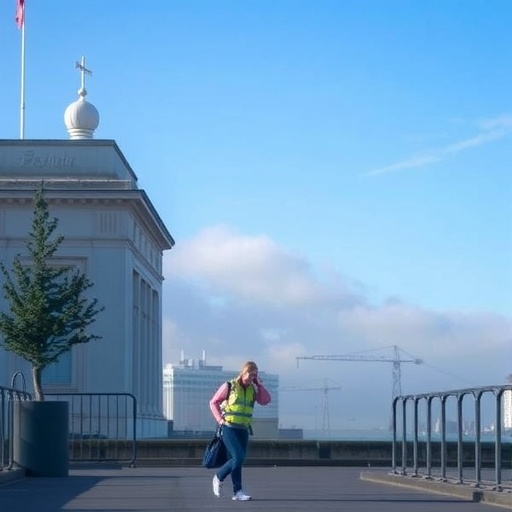In a revealing new study, researchers from Liverpool have meticulously unveiled the hidden aspects of air pollution that disproportionately affect deprived youth within the city. The study, titled “Breathing Inequality,” sheds light on the stark contrasts in environmental health burdens that specific demographics experience, drawing attention to how socio-economic factors can exacerbate exposure to harmful pollutants. This groundbreaking research combines data, geographical mapping, and social analysis to present a comprehensive picture of pollution’s impacts on vulnerable communities.
Air quality has long been recognized as a public health concern; however, the nuances of how it interplays with economic disparity are less understood. The researchers employed sophisticated modeling techniques and extensive datasets to track pollution levels across various neighborhoods in Liverpool. Their findings indicate not only elevated levels of airborne toxins in less affluent areas but also underline the connections to health outcomes in children, who are particularly susceptible to the adverse effects of such exposure.
The crux of the research reveals that youth living in socio-economically disadvantaged regions of Liverpool are breathing in levels of pollution far exceeding what is considered safe. It underscores a fundamental inequality that has often been ignored in urban planning and environmental policy discussions. By correlating pollution data with local health records, the study compellingly supports its thesis that socio-economic status is a key determinant of environmental exposure among young people.
Furthermore, this study is an important call to action for both local authorities and policymakers. It encourages them to re-evaluate how urban environments are structured and governed. With the increasing urgency of climate change and public health crises, there is a pressing need for interventions that address both air quality and social equity. The researchers advocate for policies that prioritize the needs of vulnerable populations, ensuring that all youth, regardless of their background, can thrive in a healthy and safe environment.
One of the most significant findings of this research is the identification of specific pollutants that are prevalent in these underserved neighborhoods. For example, nitrogen dioxide and particulate matter levels were found to be alarmingly high, correlating directly with incidences of respiratory problems in young residents. This information is critical because it does not only highlight the problem but also directs attention to specific pollutant sources, enabling targeted interventions to improve air quality.
In addition, the researchers elaborated on the intersection of socioeconomic status with geographic location, illustrating how urban development often ignores the needs of lower-income communities. Industrial zones, traffic-heavy roads, and inadequate green spaces all contribute to the environmental burdens faced by these populations. The researchers argue that addressing these disparities should become an intrinsic aspect of urban planning to foster a more equitable living environment.
Moreover, the impact of this air quality crisis on mental health has not gone unnoticed in the study. Increased levels of pollution have been linked to rising cases of anxiety and depression among children, further compounding the challenges faced by families in these communities. Therefore, the study’s emphasis on a holistic approach to tackling air pollution is particularly relevant, suggesting that improvements in air quality can lead to enhanced mental well-being for youths.
As the researchers published their findings, they called for community engagement in the fight against these imbalances. They believe that involving residents in discussions about environmental health can empower them to demand changes and take ownership of their communities. This citizen science approach invites dialogue between scientists, policymakers, and local populations to collaboratively address these pressing issues.
The urgency of establishing clean air initiatives is also paramount. The researchers proposed that providing better public transportation options can dramatically diminish traffic-related pollution. Improved green spaces should also be developed, as trees can absorb contaminants and enhance air quality. Additionally, regulatory frameworks must be revised to ensure stricter emissions standards, particularly for industries operating near residential areas.
On a global scale, the implications of the Liverpool study resonate with trends seen in other urban areas. Many cities are grappling with similar disparities, where those less economically advantaged bear the brunt of environmental hazards. The authors highlight the importance of sharing knowledge and strategies between cities facing similar challenges, emphasizing collaboration as a key component in rectifying these inequalities.
Furthermore, this research dovetails with broader discussions about climate justice, advocating for systemic change rather than piecemeal fixes. The researchers stress that climate change disproportionately impacts marginalized communities, reinforcing existing inequalities. By prioritizing both environmental justice and public health in a concerted effort, significant strides can be made to ensure that future generations inherit a cleaner, safer planet.
In conclusion, the implications of the “Breathing Inequality” study extend far beyond Liverpool’s boundaries. It serves as a clarion call for urgent action and policy reform aimed at addressing the intersection of socio-economic status and environmental health. The profound impacts that poor air quality has on vulnerable populations, especially children, cannot be understated. With appropriate measures in place, Liverpool can emerge as a leading example for other cities, creating an equitable blueprint for urban living that safeguards the health and well-being of all its residents.
The researchers have laid down a compelling framework that not only identifies problems but also suggests actionable solutions aimed at improving air quality and, consequently, public health. As communities rally together to demand change, there is an opportunity for a transformative shift towards equity in environmental health. The hope is that by prioritizing these issues, we can collectively breathe easier in the future.
Subject of Research: Air Pollution and Socioeconomic Disparities in Liverpool
Article Title: Breathing inequality: unmasking Liverpool’s air pollution burden on deprived youth
Article References:
Higham, J.E., Sinha, I., Lee, A. et al. Breathing inequality: unmasking Liverpool’s air pollution burden on deprived youth.
Environ Monit Assess 197, 1128 (2025). https://doi.org/10.1007/s10661-025-14594-2
Image Credits: AI Generated
DOI: 10.1007/s10661-025-14594-2
Keywords: Air Pollution, Youth Health, Socioeconomic Inequality, Environmental Justice, Urban Planning




